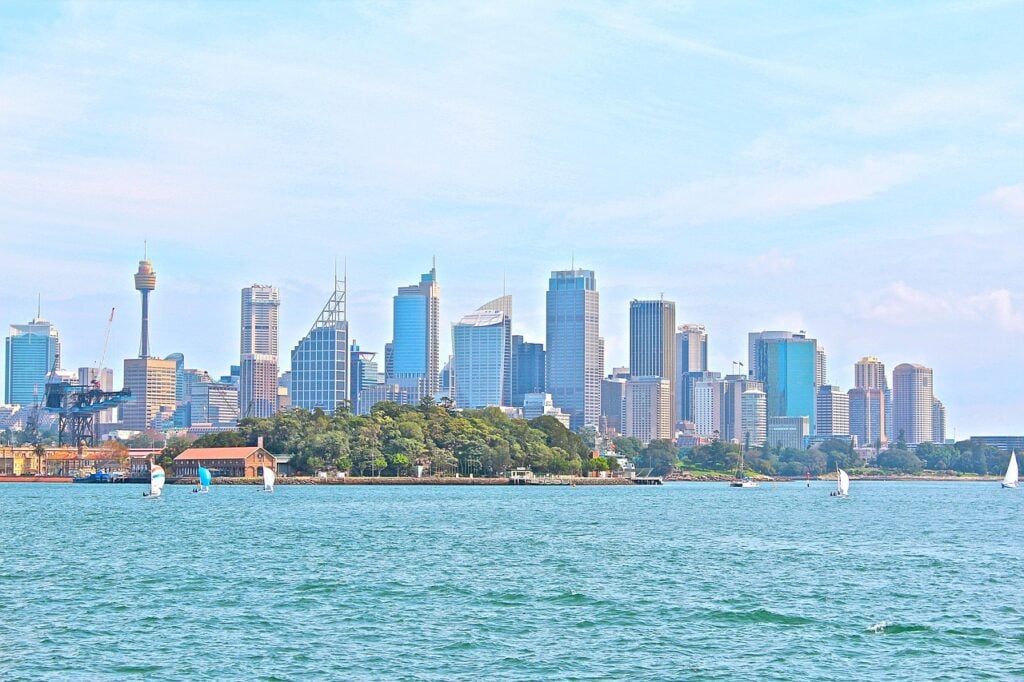Sydney is one of the most visited cities in Australia. It has a lot to offer with its famous landmarks, restaurants and beaches. But it can be difficult to know what locations are best suited for you during summer.
For your convenience, we have compiled a list of some great Sydney locations that will guarantee happiness all through the hot season!
The Rocks is an amazing location that offers visitors plenty of things to do such as museums and galleries, shopping or even just sitting by the water looking out over Sydney Harbour. If you’re looking for something more active then head on down towards Bondi Beach where you’ll find world-famous surfers sunbathing on golden sands while others enjoy drinks at beachside cafes or watch people walking along beautiful
The image which first pops up into our minds when we hear the word, ‘SYDNEY’ is that of a canvas painting, with the opera house, the arched harbour bridge and speedboat making its way from the horizon into our perceptive gaze.
Sydney is a destination all travel mongers hype. However, the capital of New South Wales, Sydney, is one of Australia’s largest and most lively cities. Sydney is a city filled with wonder, excitement, and vigour. There are so many things to be explored in this city.
Enjoy the sun and sand along the breathtaking beaches of Bondi and Manly. Then, climb or jump off the harbour bridge.
Take a helicopter ride over the city. Grab a front-row seat at the Australian Open, V8 Supercars Sydney 500, or Sydney Sevens Rugby. If you’re vacationing with the entire family, get wet and wild in NSW’s most famous water park.
You’ll be leaving Sydney only to want to experience more of it, scratch the surface, and it promises only to get better. So here is a list of things “to do” in Sydney, which are bound to be visual treats for you and your group.
The place accommodates all sorts of people and is as welcoming as your nation-state.
There are beaches, parks, and a number of other attractions that will make your time in Sydney unforgettable. But where should you go? Here are some of the best Sydney locations for summer.
1. Sydney Opera House
One of the most famous landmarks globally, the Sydney Opera House, is an architectural marvel. Its different roof is shaped like billowing sails, with the massive structure perched on a stretch of land surrounded by sparkling blue water.
Sydney Opera House sits on Bennelong Point. Bennelong Point was named after Woollarawarre Bennelong, a senior Eora man at the time of the arrival of British colonists in Australia in 1788.
The original cost estimate to build Sydney Opera House was $7 million. The final cost was $102 million, and a State Lottery essentially paid for it.
Two hundred thirty-three designs were submitted for the Opera House international design competition held in 1956. Jørn Utzon from Denmark was announced the winner, receiving ₤5000 for his design.
Construction was expected to take four years. It took 14 years. Work commenced in 1959 and involved 10,000 construction workers.
Paul Robeson was the first person to perform at Sydney Opera House. In 1960, he climbed the scaffolding and sang Ol’ Man River to the construction workers as they ate lunch.
Queen Elizabeth II opened the Sydney Opera House on 20th October 1973. She has since visited four times, most recently in 2006.
When the Sydney Symphony Orchestra is on stage in the Concert Hall, the temperature must be 22.5 degrees to ensure the instruments stay in tune. Temperature and humidity are critical to musical instruments.
Arnold Schwarzenegger (former actor and Governor of California) won his final Mr Olympia bodybuilding title in 1980 in the Concert Hall.
A net was installed above the orchestra pit in the Joan Sutherland Theatre during the 1980s following an incident during the opera Boris Godunov. The opera featured live chickens, and one bird walked off the stage and landed on top of a cellist.
More than 10.9 million people visit the Opera House every year.
Sydney Opera House is cooled using seawater taken directly from the harbour. The system circulates cold water from the pier through 35 kilometres of pipes to power both the heating and air conditioning in the building.
Lunar New Year is celebrated at the Opera House with sails lit in red, Lunar Lanterns and Mandarin tours.
Snap a photo while you’re on a harbour cruise, or stop by for a tour of its theatres, exhibits, concert hall, and cinema.
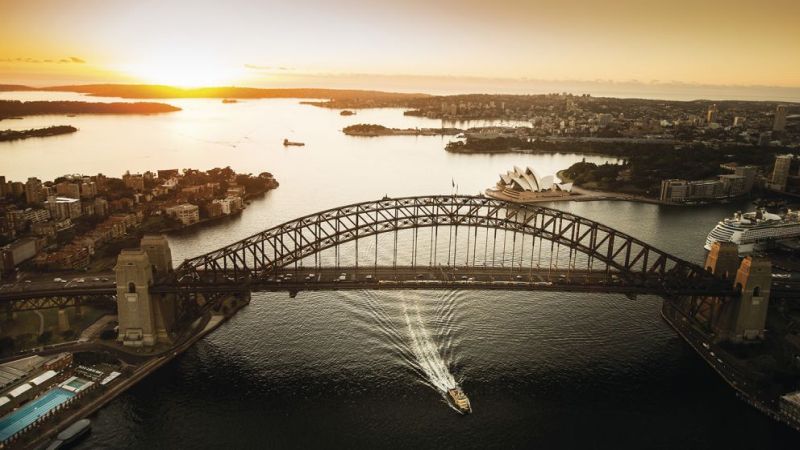
2. Sydney Harbour Bridge
The Sydney Harbour Bridge is one of Australia’s most famous landmarks. Built in 1932, this incredible feat of engineering uses almost 53,000 tonnes of steel to connect the Sydney CBD with the northern suburbs.
Before its construction, Sydney residents hoping to cross the harbour would either have to board a ferry or undertake a 20-kilometre journey with five separate bridge crossings. Nowadays, pedestrians can walk from one side of Sydney Harbour to the other in just 15 minutes.
‘Coat Hanger’ to the locals, the Sydney Harbour Bridge is the world’s largest steel arch bridge. It connects the north and south piers of the harbour in a single curve.
Although New York’s Hell Gate Bridge inspired its design, the Sydney Harbour Bridge is over 50% larger than its American counterpart. Standing 134 metres above the waters of Sydney Harbour, it remains the tallest steel arch bridge in the world today.
Those up for an adventure should consider taking on the BridgeClimb; this 1.5–3.5 hour experience will reveal stunning views of Sydney from the top of the bridge.
For a different perspective, jump on a ferry from Circular Quay to westerly destinations such as Luna Park, Cockatoo Island, or McMahons Point. Gliding directly beneath the Sydney Harbour Bridge will give you an awe-inspiring sense of the magnitude—and the importance—of Sydney’s iconic bridge.
Dare to climb the 135-meter-high summit? BridgeClimb Sydney takes groups of up to 13 people to the top of the outer arch.
The climb lasts for around three and a half hours. However, if you are not that adventurous, you can still enjoy an Instagram-worthy panorama of the city and harbour from the walkway.
3. Royal Botanic Garden
Providing a tranquil sanctuary from fast-paced city life, the Royal Botanic Gardens at Farm Cove are a short scenic stroll from the Opera House.
The enchanting Royal Botanic Garden, Sydney, is a tranquil oasis on the edge of one of the world’s excellent natural harbours. You’ll enjoy spectacular views and take memorable photographs of Sydney Harbour, the Sydney Opera House and the Sydney Harbour Bridge.
A short walk from Circular Quay and Hyde Park, the garden has thousands of plant specimens. Wildlife in the garden includes colourful birds, fruit bats and water dragons. The Calyx is a world-class horticultural space with changing exhibitions designed to capture your imagination.
Discover the area’s rich Aboriginal history on the 90-minute guided Aboriginal Heritage Tour. You’ll explore traditional plant uses and culture and taste some bush foods. Reservations are essential. The tour departs at 10 am on Wednesday, Friday and Saturday, and is available for groups on request.
Enjoy the lush greenery across 30 hectares with palm groves, orchids, and ferns. The Palace Rose Garden is a must-see with its nearly 1,800 species of roses.
Entry is free into the gardens, open daily from 7 am. The nearest train stations are Circular Quay and Martin Place.
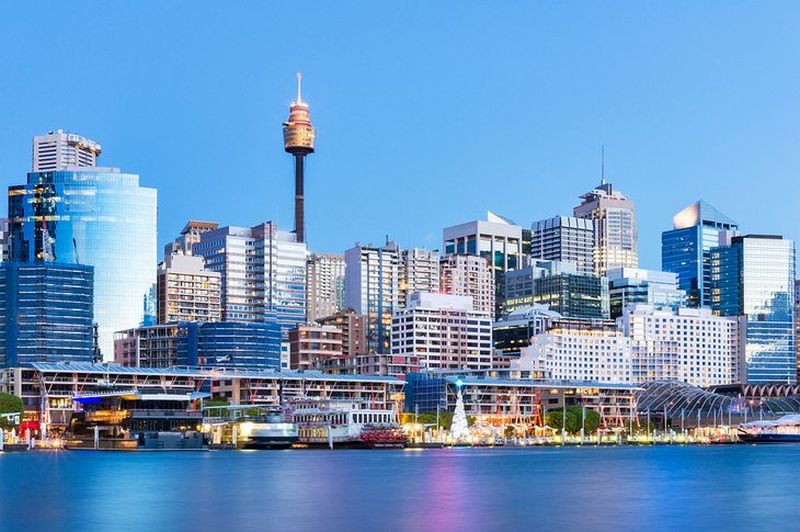
4. Darling Harbour
Darling Harbour ticks all the destination boxes, matching a splendid waterside location in the heart of Sydney with some marvellous attractions such as an aquarium and excellent dining options. Cockle Bay and King Street Wharf offer funky nightclubs, wine bars, and restaurants serving refined food and delicious cocktails within the area.
Darling Harbour is a waterfront entertainment hub. Next to the central business district is the Aquarium Wharf, where you’ll find Madame Tussauds wax museum, the Australian National Maritime Museum, and SEA LIFE Sydney Aquarium – home to the world’s most extensive collection of Australian marine creatures.
At Darling Harbour, a short walk from the city centre, discover unique Australian animals, waterfront dining, intriguing history and exciting nightlife. As one of Sydney’s most extensive dining, shopping and entertainment precincts, it has a full calendar of events.
Two of the most popular attractions are the SEA LIFE Sydney Aquarium and the WILD LIFE Sydney Zoo.
You’ll be enthralled getting up close to native animals such as koalas and kangaroos and watching sharks and dugongs.
Near the zoo and aquarium is King Street Wharf, where ferries and cruises arrive and depart. The pier also has quality restaurants and trendy bars with plenty of outdoor dining areas. Dance the night away at the funky nightclubs on the dock.
Other big-name attractions in Darling Harbour include the world’s most giant cinema screen at IMAX, laser skirmish and tenpin bowling, Madame Tussauds, shopping, harbour cruises, and plenty of outdoor events and exhibitions year-round.
Across the Pyrmont Bridge, on the western side, is the Australian National Maritime Museum, where you can climb aboard a submarine, destroyer and sailing ship. You’ll also find more restaurants serving fresh seafood and other delectable dishes.
Walk south to the Chinese Garden of Friendship, a tranquil haven filled with waterfalls, lakes, exotic plants and hidden pathways. Darling Quarter Playground will keep the kids entertained with water games, climbing ropes, slides, and swings for hours.
Darling Harbour offers several comfortable places to stay, from serviced apartments and corporate rentals to luxury hotels at venues such as The Star, Hotel Ibis and the Novotel.
There is a fun activity for any age with an IMAX and 9D Action Cinema, Chinese garden, harbour jet boat rides, interactive exhibits, race car adventures, playground, and water park.
5. Taronga Zoo
Taronga Zoo Sydney is a zoo located in Sydney, New South Wales, Australia, in the suburb of Mosman, on the shores of Sydney Harbour.
With spectacular views of beautiful Sydney Harbour, Taronga Zoo is a great destination to see native wildlife and rare exotic animals. A range of tours is offered, from the keeper-led Wild Australia Experience to the VIP Aussie Gold Tour of native animals.
It was officially opened on 7th October 1916. Taronga Zoo Sydney is managed by the Zoological Parks Board of New South Wales, under the trading name Taronga Conservation Society, and its sister zoo, the Taronga Western Plains Zoo in Dubbo.
Divided into eight zoogeographic regions, the 28-hectare (69-acre) Taronga Zoo Sydney is home to over 4,000 animals of 350 species, making it the largest zoo in Australia. It has a zoo shop, a cafe, and an information centre.
Encounter exotic wildlife up close at Taronga Zoo. Then, ride the ferry at Circular Quay to see the Lemur Adventure Park, Seal Show, and Koala Encounter.
At 3.04 am on 4th July 2009, Thong Dee, an Asian elephant, gave birth to a male calf named Luk Chai. He is the first calf ever born in Australia. Thong Dee, and his father Gung, were two of the eight elephants imported into Australia to participate in the Australasian Conservation Breeding Program.
A further two calves were expected to be born at Taronga in the following two years. The baby elephant is a significant tourist attraction, with thousands of visitors attending the zoo to see him.
A baby Asian elephant was thought to have died during labour on 8th March 2010. The calf’s 18-year-old mother Porntip was in and out of work over the week beforehand, after a pregnancy lasting almost two years.
Zookeepers and veterinarians were concerned about the progress of the labour, with Porntip showing unusual movements and behaviour.
An ultrasound revealed that the calf was unconscious in the birth canal, and the zoo announced on 8th March 2010 that the calf was believed to be dead.
On 10th March 2010, at 3:27 am, the live male calf was born. He was subsequently named Pathi Harn, a Thai expression meaning “miracle”. Pathi Harn’s father is Bong Su, of the Melbourne Zoo, and was artificially conceived.
In October 2012, Pathi Harn critically injured his keeper by crushing her against a pole.
You’ll be delighted with the daily bird and seal shows too. The Nura Diya Aboriginal Discovery Tour explores the connection between Australia’s animals, plants, landscape, and Aboriginal Dreamtime. You can even camp the night at the zoo on the Roar and Snore tour.
Taronga Zoo has an interactive iPhone app that guides you to the most popular native and exotic animals for independent visitors.
A Mandarin-language map is also available as a walking route to see as many unique Australian animals in 60 or 90 minutes.
Ever wanted a bird’s-eye view? Then, try the Wild Ropes adventure with its zip-lines and suspension bridges. The zoo is open daily from 9.30 am to 4.30 pm.
Take a ferry from Circular Quay near The Rocks and the city centre to get to the zoo. The journey takes 12 minutes.
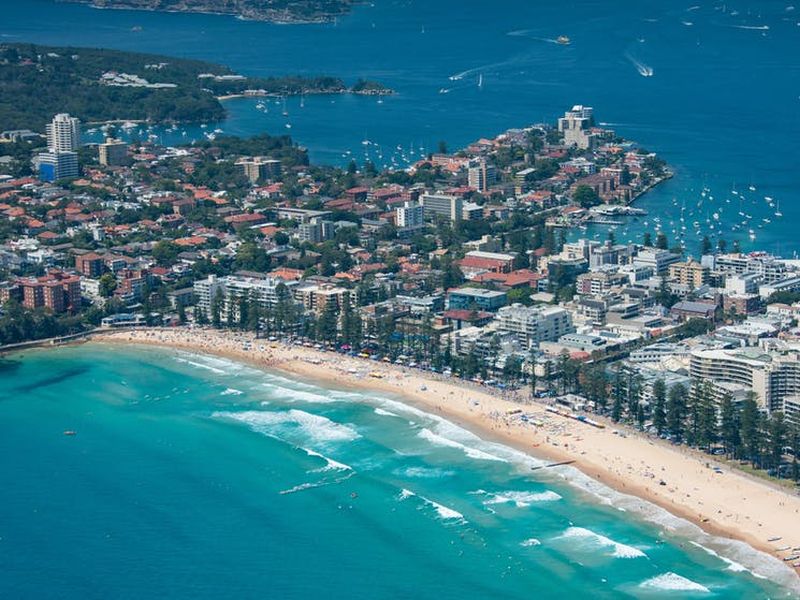
6. Manly Beach
Watch skilled surfers ride the waves at Manly Beach, where the Australian Open of Surfing is held in February. Buy fish and chips on the lively Corso and head to the beach to enjoy them and watch all the action.
You’ll find plenty of beachside cafés, bars and restaurants. There are popular pubs on the Corso, such as the Ivanhoe Hotel Manly and Hotel Steyne. Manly Wharf, overlooking Sydney Harbour, also has quality restaurants, such as Papi Chulo. In addition, the 4 Pines Brewing Co serves its own craft beers opposite the pier.
Next to Bondi, Manly Beach is the favourite seaside destination for Sydney tourists. Its beautiful promenade, netted ocean pool, sandbanks, and spilling waves are perfect for sun, swim, and surf activities. Manly has produced a long list of champion surfers, including Layne Beachley, Barton Lynch, Pam Burridge, and Midget Farrelly.
Manly Beach is one of Australia’s most famous surfing beaches – the first world surfing championship was held here in 1964. With a tree-lined promenade and a long stretch of fine soft sand, the beach is a popular destination for backpackers and families.
Take a ferry at Circular Quay near the Sydney Opera House for a 30-minute trip across Sydney Harbour to Manly Wharf for a delightful day out.
At the northern end of the beach is Queenscliff headland, where an offshore submerged reef, or bombora, creates the kind of waves prized by top surfers.
A short stroll south from the Corso brings you to pretty Shelly Beach, a sheltered area famous for snorkelling, diving, barbecues and picnics.
Dive Centre Manly offers scuba diving courses for beginners and guided dives for certified divers. For surfing lessons, check-in at Manly Surf School.
Accommodation options in Manly range from luxury hotels to youth and backpacker hostels.
Explore the coastline on a bicycle from Manly Bike Tours, heading north to Freshwater Beach, the historic home of Australian surf culture.
Both Manly and Freshwater beaches are on the National Surfing Reserves as significant surfing locations.
7. Hyde Park
Hyde Park is Australia’s oldest park. Divided by Park Street, the southern section of Hyde Park contains the ANZAC Memorial building and visitor centre, the pool of reflection and numerous monuments and statues.
The northern section features the iconic Archibald Fountain and various theme gardens, including Sandringham and Nagoya Gardens, replete with public artworks, monuments and water features.
Just like Central Park in Manhattan, Hyde Park breathes life into the hustle and bustle of Sydney’s central business district.
Named after Hyde Park in London, the Sydney version is a sanctuary of sprawling lawns, picnic spots, flora and fauna, fountains, and patches of green.
Stroll around for a quick snapshot of Archibald Fountain, Anzac War Memorial, Hyde Park Barracks, and St. James Church.
The park contains around 580 mature exotic and native trees, including the historic central avenue of Hill’s Figs which line the main pedestrian avenue running from Macquarie Street to the ANZAC Memorial.
The park hosts several cultural events throughout the year, including the Sydney Festival, Australia Day, ANZAC Day and the Food and Wine Fair.
The park is a popular attraction, workers and tourists congregating throughout the year to enjoy the varied sights and sounds of this green iconic and central public space.
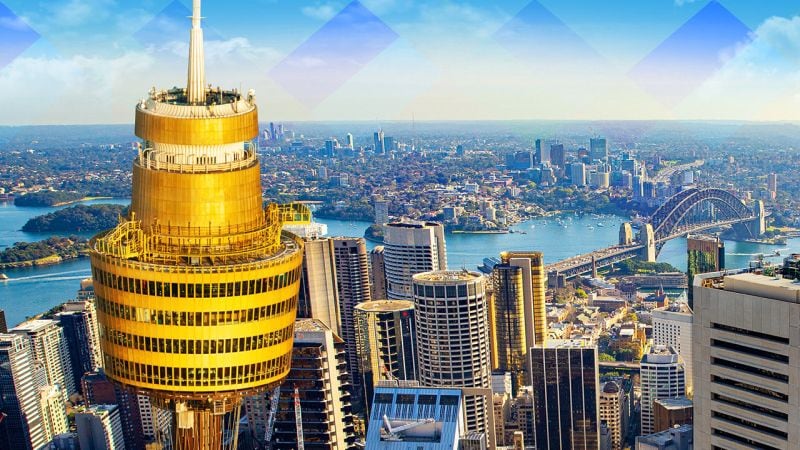
8. Sydney Tower
The Sydney Tower Eye – often referred to by Sydneysiders as Sydney Tower, Centrepoint Tower, AMP Tower, Westfield Centrepoint Tower or Sydney Skytower, amongst other names – has been an integral part of the famous Sydney skyline for the past 30 years.
Soaring high above the city skyline is the 309-meter Sydney Tower. From the window of your Sydney accommodation, you’ll probably be able to get a glimpse of the city’s tallest structure.
Express lifts take visitors to the observation deck or the Skywalk, which offers a 360-degree panoramic view of Sydney from an alfresco glass-floor viewing platform.
Sydney Tower Eye is a must-do while in the city that takes you to the highest point above Sydney for breathtaking 360-degree views of our beautiful harbour city, including the Sydney Harbour Bridge and Sydney Opera House, along with a fantastic vista that stretches from the Sydney CBD out to the distant horizons of the Blue Mountains.
Eighteen different binoculars will let you peer out to a distance of up to 100 kilometres in every direction or zoom in on the point of interest.
You’ll be amazed by Sydney’s best views, from the golden beaches in the east to the distant Blue Mountains!
Please note that the SKYWALK experience is sold separately.
9. The Rocks
Get a sense of Sydney’s past exploring The Rocks‘ cobbled laneways, cosy cafés and Australia’s oldest pubs. In this historic precinct, you’ll find great places to stay, eat, drink and shop – and a buzzing annual events calendar.
Rent a bicycle in The Rocks from the likes of Bonza Bike Tours and Sydney Bike Tours and pedal to the harbour’s iconic attractions.
Also near your Sydney accommodation around the harbour is a historical place called The Rocks. Its name came from the rocky coast of Sydney Cove, where convicts used to pitch their tents.
Today, there are more than 100 heritage sites and buildings lining the narrow cobbled streets. Visit Sydney’s oldest surviving house – Cadman’s Cottage – or join an Aboriginal heritage walk or a night-time ghost tour.
As the strip of land where European settlers chose to step ashore in 1788, The Rocks is essentially the birthplace of modern Sydney. A colourful history, The Rocks evolved from a rowdy, raucous settlement of convicts, soldiers, sailors and street gangs into a thriving, trendy precinct.
On the edge of one of the world’s excellent natural harbours, The Rocks is a popular place to stay and visit with a range of accommodation, attractions, funky bars and restaurants, and Australia’s oldest pubs.
Stroll on the foreshore for splendid views of the Sydney Opera House and the harbour.
Step back in time with The Rocks Walking Tours or wait outside historic Cadman’s Cottage every evening at 6 pm for the I’m Free Tour.
On the tours, you’ll explore the laneways, pubs and heritage buildings and learn stories of the precinct’s striking past.
Tourists and Sydneysiders alike flock to the markets. Bring a healthy appetite on Fridays to The Rocks Foodies Market and its mouth-watering stalls. Browse for gifts and souvenirs at over 200 stalls at The Rocks Markets on Saturdays and Sundays.
A creative and cultural arts destination too, The Rocks is home to the Museum of Contemporary Art Australia and artisans, poets or bespoke craftsmen in The Rocks pop-up project. Be sure to check out the Argyle Gallery and The Rocks Discovery Museum, too.
Thinking of staying in the area? The Sydney Harbour YHA offers budget rooms and great views, The Harbour Rocks Hotel is a good mid-range option, and luxury hotels include the Four Seasons, Park Hyatt, Quay West Suites, Shangri-La and The Langham.
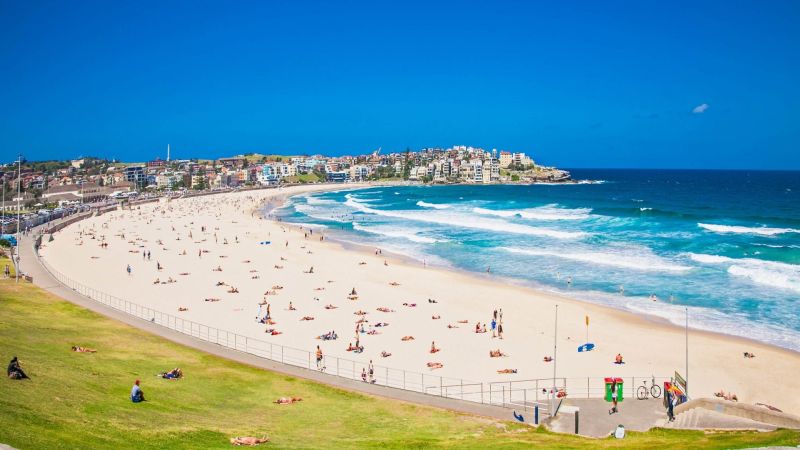
10. Bondi Beach
Sydney is famous for its fabulous beaches, and there is no shortage of Sydney accommodation options even during peak months in the summer.
Get up early for a stroll along the famous beach or go for a refreshing morning swim before breakfast at one of the cafés on Campbell Parade.
You’ll find public showers on the beach to wash off the salt after a swim in the ocean. Enjoy the views along the Bondi to Coogee Coastal Walk. Play nine holes at Bondi Golf Club.
Join the crowds at Sculpture by the Sea in October and November, an outdoor exhibition of artworks along a 2 km coastal walk. Buy takeaway fish and chips on Campbell Parade and enjoy them at the beach. Sip cocktails at Icebergs as the Sunsets over the ocean.
Located just 7 kilometres from the central business district is the iconic Bondi Beach. Dig your feet into the sugary white sand or ride the waves on your surfboard. Check out the laid-back cafes and casual pubs for a relaxing afternoon.
Bondi Beach is an iconic stretch of fine sand and curling waves and one of the world’s most famous beach destinations. You’ll enjoy Bondi at any time of the year. The beach is flanked by sandstone headlands, which are renowned for walking, golfing and whale watching.
Bondi Beach is 30 minutes from Town Hall Station by train and bus and offers visitors insights into Australia’s easy-going beach culture. You can learn more about the beach and its history and meet a Bondi surf lifesaver on Let’s Go Surfing’s Discover Bondi Walking Tour.
Picnics and fish and chips on the beach are popular, or dine out at one of the vibrant cafés and bars overlooking the beach on Campbell Parade and in nearby streets.
Shopping for beach fashion and swimwear by Australian and international designers is a great way to spend a few hours. Places to stay range from hostels to stylish apartments.
Even complete novices can learn to surf at one of the accredited surf schools—Marvel at the skill of board-riders surfing near the beach’s southern end.
On weekends mingle with locals at Bondi Farmers Market on Saturday and the Bondi Markets on Sunday.
Eating out is one of the attractions at Bondi. You’ll find award-winning restaurants with great views at both ends of the beach, which stretches for 1.5 km. Sean’s Panorama is at the northern end, and Icebergs Dining Room and Bar is to the south.

